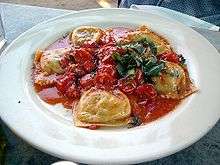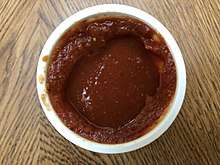Marinara sauce
Marinara ("mariner's") sauce is a tomato sauce usually made with tomatoes, garlic, herbs, and onions.[1][2] It can include the addition of capers, olives, spices, and a dash of wine as possible ingredients in its many variations.[3][4] This sauce is widely used in Italian-American cuisine, which has diverged from its Old World origins.[5]
 A plate of ravioli alla marinara | |
| Course | Main course |
|---|---|
| Place of origin | Italy |
| Serving temperature | Hot over pasta or in a pizza |
| Main ingredients | Tomatoes, garlic, onions, basil, oregano |
| Variations | Olives, capers |
In Italy, alla marinara refers to a sauce made with tomatoes, basil, and oregano, but also sometimes olives, capers and salted anchovies; it is used for spaghetti and vermicelli, but also with meat or fish.[6] This is not to be confused with spaghetti marinara, a popular dish in Australia, New Zealand, Spain and South Africa, in which a tomato-based sauce is mixed with fresh seafood.[7] In Italy, a pasta sauce including seafood is more commonly called alla pescatora.[6]
Origin

Several folk theories exist as to the origin of this sauce. One version states that cooks aboard Neapolitan ships returning from the Americas invented marinara sauce in the mid-16th century after Spaniards introduced the tomato (a central Mexican "New World" fruit) to Europe. Another theory states this was a sauce prepared by the wives of Neapolitan sailors upon their return from the sea.[8]
Historically, however, the first Italian cookbook to include tomato sauce,[9] Lo Scalco alla Moderna ('The Modern Steward'), was written by Italian chef Antonio Latini and was published in two volumes in 1692 and 1694. Latini served as the Steward of the First Minister to the Spanish Viceroy of Naples.[9][10][11] This early tomato sauce was more like a modern tomato salsa.
A sauce similar to Italian-American marinara sauce is known in some areas of Central Italy as sugo finto.[12]
See also
- List of sauces
- List of common dips
- List of condiments
References
- "Definition of marinara sauce on the Oxford Dictionary website". Retrieved 10 December 2013.
- "Definition of marinara sauce on the Your Dictionary website". Yourdictionary.com. 17 April 2013. Retrieved 3 May 2013.
- De Laurentiis, Giada. "Marinara Sauce". foodnetwork.com. Archived from the original on 31 May 2017. Retrieved 3 May 2013.
- Batali, Mario (5 October 2007). "Mario Unclogged: Marinara Sauce Recipe". Serious Eats. Archived from the original on 11 October 2007. Retrieved 3 May 2013.
- "Ten "Italian" Foods You Won't Find in Italy". 4 March 2013. Retrieved 22 May 2018.
- Marco Guarnaschelli Gotti (2007) [1990]. Università degli Studi di Scienze Gastronomiche (ed.). Grande enciclopedia illustrata della gastronomia [Great Illustrated Encyclopedia of Gastronomy] (in Italian). Milan: Mondadori. ISBN 978-88-04-56749-3.
- "Recipe for Marinara from an Australian website". Retrieved 15 May 2017.
- "Info on the origin of marinara sauce on the Italian Chef website". Italianchef.com. 24 April 2013. Retrieved 3 May 2013.
- Elizabeth David, Italian Food (1954, 1999), p 319, and John Dickie, Delizia! The Epic History of the Italians and Their Food, 2008, p. 162.
- Alan Davidson, "Europeans' Wary Encounter with Tomatoes, Potatoes, and Other New World Foods" in Chilies to Chocolate: Food the Americas Gave the World, (University of Arizona Press) 1992.
- Olver, Lynne. "Origins of Italian tomato sauce". The Food Timeline. Retrieved 3 April 2011.
- Paolo Petroni (1985) [1974]. Il libro della vera cucina fiorentina [The Book of True Florentine Cuisine] (in Italian) (13 ed.). Florence: Bonechi. p. 41. ISBN 88-7009-023-X.
External links
| Wikimedia Commons has media related to Marinara sauce. |

